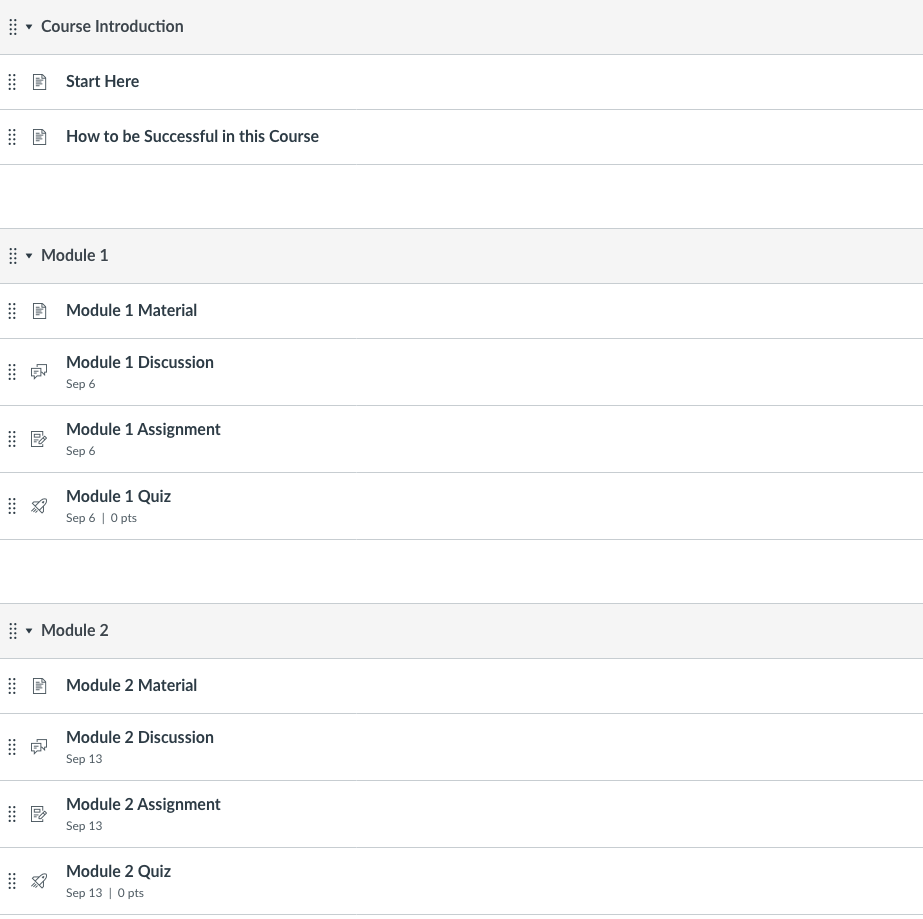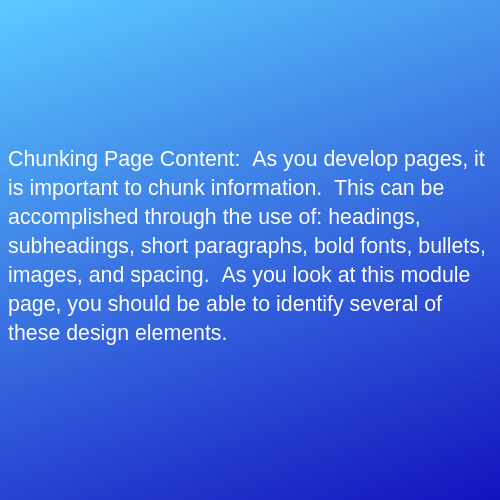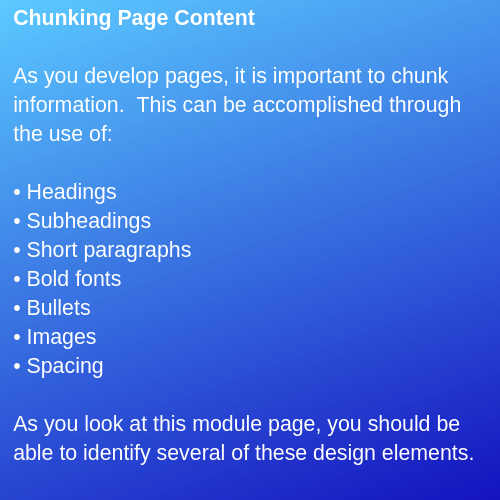Plan Learning Activities
Design Considerations
Prior to the start of your course, you will need to consider the types of activities and assessments you will use. Remember these should align with module and course learning objectives. Best practices encourage a mixture of high and low stakes activities. Activities and assessments should also progress from formative to summative: students should have opportunities to receive and learn from feedback before engaging in high-stakes summative assessments.
Online courses should contain more than quizzes and exams. Just like traditional face to face classes, there are numerous ways in which students can demonstrate their learning. In addition, consider the weight each type of activity or assessment has on a student's final grade.
Types of Activities
Within Canvas, you have several options to create activities that allow students to practice and demonstrate their learning. These can be graded or ungraded. Keep in mind that graded activities encourage student participation. Within Canvas, when you create a graded activity, it is automatically linked to the grade book and student calendars.
Almost any activity may be created in Canvas. Since you don't meet in person, directions will need to be very detailed and specific. As you become more confortable teaching online, consider introducing a variety of technology tools which allow students to present their knowledge using audio, video, and text based formats. Even a simple introduction can be enhanced using narrated slides with pictures. Here are some activity ideas to help you get started.
Introductions
As the course begins, prepare a video or slide show introducing yourself. Set specific expectations and have students do the same. This is an effective ice breaker activity that allows students to get to know one another. Create this activity as a discussion forum and have students respond to several peers. Using this strategy to build a sense of community at the beginning of a course helps create a safe and trusting environment. You also set an initial expectation that students will engage with each other.
Reading / Video Guides
Reading and watching videos can often result in a passive learning style. To engage students more actively, provide a guide that allows them to examine the most important aspects of the content. At times, these guides may be knowledge based. However, you should try to create questions which allow practical application of student learning. These may be graded or ungraded.
Journals
Journals are a powerful tool that allow students to engage in reflection and critical thinking. When creating a journal entry, students must synthesize their thoughts and present them in a concise format. Typically journal entries will ask students to reflect on a unit of study or learning module. Prompts for the journal might include:
- What was most beneficial to your learning in this module?
- What was most challenging in this module?
- How can you apply content from this unit to your current or future career
Journals allow instructors to gain additional insight into student learning. Your feedback to each student becomes another way to interact with them on a more personalized level.
Discussions
Discussions allow students to share their thoughts and ideas about a topic and respond to other participants. These are similar to face to face discussions, except students typically type their responses. Discussions allow students to learn from each other and gain an understanding of other people's perspectives. In many traditional classes, a few students dominate the discussion. Some students never get a chance to be heard, especially those who are shy or reserved. Online discussions allow everyone's thoughts to be shared.
Group Work
Students should be engaged with each other on a regular basis. Group work is one way to ensure there is interaction among peers. A host of technology tools makes collaborating much easier than one might think. Students may hold virtual meetings using tools such as Google Hangouts or Zoom. Google Docs allows shared access to documents. As the instructor, make sure group activities are comprehensive enough that students see the benefit of working together. Consider incorporating a peer evaluation rubric to encourage equitable contributions by all group members.
Presentations
Even though you are not meeting face-to-face, students can still create presentations and share their learning with the class. These presentations may include audio, video, or infographic formats.
Debates
With specific guidelines, debates can take place in asynchronous courses. Groups may work together to research a topic and present their views. You will want a spokesperson for each group and assign that person the role of sharing their group’s argument. The debate can be text-based or created using audio/video. Specific dates will need to be set for the initial argument and rebuttal. You should plan to play the role of moderator and facilitate the debate. Groups will work behind the scenes to prepare content for their presenter.
Case Studies
Case studies provide an opportunity for students to examine real-world problems or concerns and apply their knowledge. Learning about mental health issues? Provide students with a case study in which they determine possible mental health disorders and treatment options. Examining instructional strategies? Provide students with a learning situation and have them design an instructional plan.
Peer Editing and Review
Reviewing a peer’s work can help students learn how others organize and interpret information. In addition, it often serves as a valuable form of feedback. You can set up a peer review system that is anonymous or allow students to create pairs. Encouraging the use of a rubric in the review will provide additional insight for both students.
Projects
Almost any project you would consider using in a traditional course may be redesigned for use in your online course. Book reviews, research papers, internet scavenger hunts, problem solving, application activities ... all can be designed for use in your course.
Backward Design
"Our lessons, units, and courses should be logically inferred from the results sought, not derived from the methods, books, and activities with which we are most comfortable"
Backward design means beginning with specific and measurable learning objectives and deciding what kind of assessments will provide the evidence needed that learning has occurred. It is the desired understandings and what they look like in practice that informs effective learning activities.
The 3-step process goes like this:
- Identify desired results (Learning Objectives)
- Determine acceptable evidence (Assessment Methods)
- Plan learning experiences and instruction (Learning Activities)
Chunking Page Content
Chunking content is important in any learning environment. It allows students to engage with information in smaller, meaningful sections. You don’t want to cognitively overwhelm or overload students. As you design your course, consider the best way to chunk the material. Many online instructors break down course content into weekly modules. If you have a course textbook, these modules may align with chapters from the book.

As you develop pages, it is important to chunk information. This can be accomplished through the use of:
- Headings
- Subheadings
- Short paragraphs
- Bold fonts
- Bullets
- Images
- Spacing
As you look at the images below, which is easier to read and comprehend? One is chunked into segments while the other is not.


Pacing
The pace of your course is an important aspect in promoting student success. It should not feel too slow for students, resulting in boredom and decreased motivation. Likewise, it should not be too fast, leaving students feeling anxious and overwhelmed. In a traditional course, you read the expressions on students’ faces to determine when you need to speed up or slow down. You do not have that opportunity in an online course.
Content, activities, and assessments will comprise your learning modules. Set a realistic goal for how much work can be completed in a week. Remember you are an expert in this area, your students are still developing their skills and may take longer than expected to complete activities. Build up starting with low stakes assignments and aim to have students turn something in at least once a week. For discussions and big projects, remember that additional time is needed to read responses and use technology tools.
Consider using a visual tool, such as a calendar, to help pace the course. Write in due dates for activities and assessments. If there is too much overlap or too heavy of a workload, students will not be able to devote adequate time to each assignment. In addition, think about your role as the instructor. Will you be able to provide timely and specific feedback for all work?
Best practice in online course delivery is to have the entire class completed at the beginning of the semester. This way students can see a big picture view of what they will be learning and can better plan for heavy weeks during the semester.
If you're not able to have the course 100% completed, you'll need to determine when modules will open for students to view. Keep this day consistent throughout the semester. If each new module opens on a Monday, with assignments due on Sunday, make sure you are available on the weekends to answer questions. Most online courses at USU follow a Monday-Sunday schedule.

